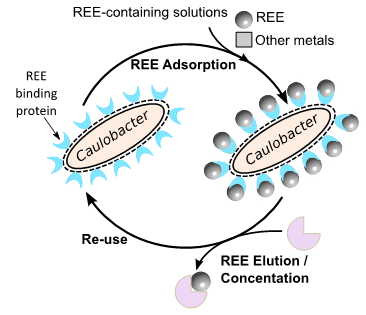Lawrence Livermore scientists have developed biotechnology for rare-earth element (REE) recovery from non-traditional feedstocks, enabling more sustainable rare-earth extraction and separation methods.
REEs are in high demand
REEs have unique physical and chemical properties that make them ideal for use in clean-energy technologies, consumer products, and defense technologies, such as magnets, lasers, computer memory, cell phones, wind and solar power, and hybrid vehicles. However, REEs are difficult to mine, as they are typically dispersed and are not often found concentrated in economically exploitable ore deposits. Conventional extraction techniques are expensive, environmentally harmful, and inefficient for materials containing low concentrations of REEs.
The development of low-cost and environmentally friendly approaches for ore processing/refining and recycling of REE-containing materials is crucial for achieving a sustainable balance between REE supply and demand.
Using biosorption for REE recovery
Our approach relies on microorganisms to extract rare earths from sources such as electronic wastes, mine tailings, geothermal fluids, and recyclable materials. Using both native microbial features as well as advanced bioengineering technologies, we engineered Escherichia coli/Caulobacter crescentus for high-density cell surface displays of lanthanide-binding tags, peptides that exhibit high affinity and selectivity for REEs. The bioengineered microbes exhibit enhanced adsorption capacity and selectivity for REEs, and the REEs can be desorbed for recovery.
We demonstrated the feasibility of REE extraction using our engineered bacterium with sediment core samples collected from a prospective REE mine. We observed no reduction in REE adsorption capacity following elution, enabling consecutive adsorption/desorption cycles without any loss of adsorbing capacity or cell viability. Our results demonstrate this technology to be a rapid, efficient, and reversible process for REE adsorption that holds great potential for industrial application.
Our innovation offers cost-effective and eco-friendly solutions
Our biosorption approach represents a low-cost and environmentally friendly alterative to ore processing and refining, with several unique advantages:
- The use of bioengineered microbes will ensure efficient and specific REE adsorption even in the presence of high quantities of competing metals.
- Adsorption occurs rapidly to save operational time.
- Desorption and reuse of biomass minimize operational costs.
- No added energy is required to drive the process.
- No strong acids are involved to minimize environmental burden.
- The specificity of REE extraction holds promise to deliver REEs of high purity.
The technology enables efficient recycling of rare earth metals from low-grade waste materials, reducing the amount of critical rare earth metals going to landfills by 35% and offering an approach for extracting and recycling rare earth metals from a variety of sources, which will further diversify the global supply chain of critical materials.
For information about licensing associated technology, please contact Annemarie Meike (meike1 [at] llnl.gov (meike1[at]llnl[dot]gov)).
Publications
D.M. Park, A. Brewer, D.W. Reed, L.N. Lammers, Y. Jiao, Recovery of Rare Earth Elements from Low-Grade Feedstock Leachates Using Engineered Bacteria, Environ. Sci. Technol. 51, 13471 (2017).
H. Jin, D.M. Park, M. Gupta, A.W. Brewer, L. Ho, S.L. Singer, W.L. Bourcier, S. Woods, D.W. Reed, L.N. Lammers, J.W. Sutherland, Y. Jiao, Techno-economic Assessment for Integrating Biosorption into Rare Earth Recovery Process, ACS Sustainable Chem. Eng. 5, 10148 (2017).
D.M. Park, D.W. Reed, M.C. Yung, A. Eslamimanesh, M.M. Lencka, A. Anderko, Y. Fujita, R.E. Riman, A. Navrotsky, Y. Jiao, Bioadsorption of Rare Earth Elements through Cell Surface Display of Lanthanide Binding Tags, Environ. Sci. Technol. 50, 2735 (2016).
People
Learn more about the engineered microbes
- E-waste-eating protein extracts rare earth elements (LLNL news, July 14, 2020)
- LLNL researchers turn to microbe beads to increase U.S. supply of rare earth metals (LLNL news, November 25, 2019)
- LLNL researchers turn to bioengineered bacteria to increase U.S. supply of rare earth metals (LLNL news, October 23, 2017)
- From the Laboratory to the World (Science & Technology Review, June 2017)
- Reducing Reliance on Critical Materials (Science & Technology Review, April 2016)
- Tiny But Mighty Potential Allies in the Toxic Metal Cleanup Effort (Science & Technology Review, April 2014)





